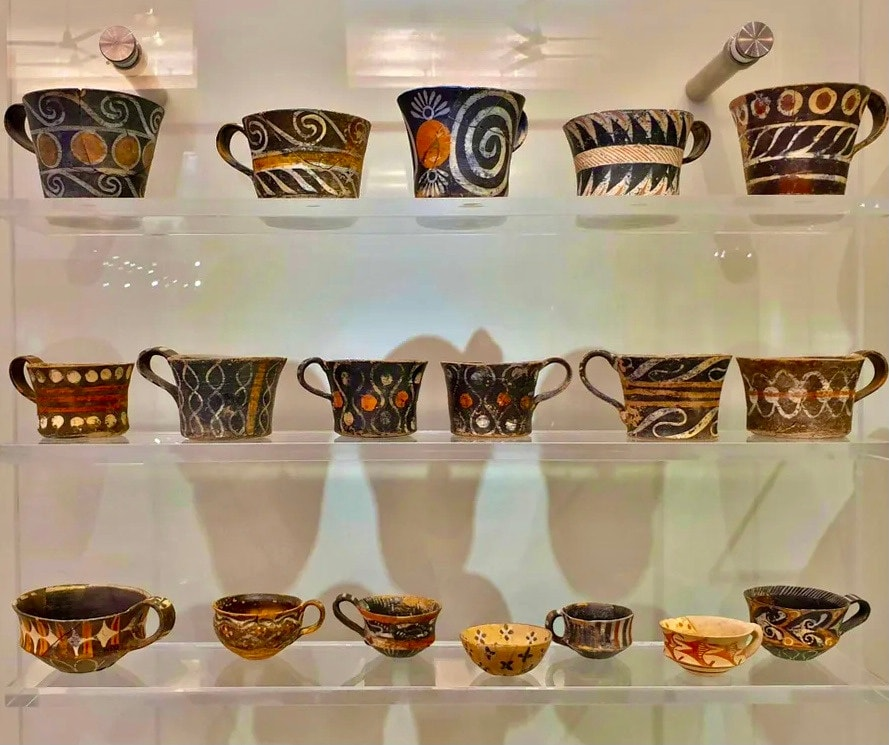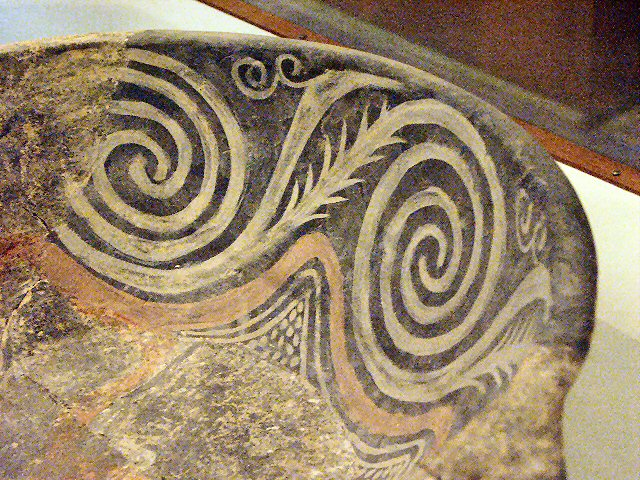The colorful cups in the photo aren’t from a modern store—they’re ancient artifacts. These exquisite Minoan cups, over 3,000 years old, are displayed at the Heraklion Archaeological Museum in Crete.
These cups represent the pinnacle of Minoan craftsmanship. Aside from their beautiful, vibrant decoration, what stands out most is their delicate, egg-shell-thin construction, making them incredibly light and fragile.
No other civilization of that time was capable of producing such intricate pieces.
Kamaraian Vessels: A Minoan Masterpiece
The cups belong to the exquisite ceramics of the Middle Minoan period, known as the Kamaraian style. These vessels are considered some of the finest examples of Minoan art.
Luxury vessels, jars, pitchers, amphorae, and other items of various shapes and sizes were adorned with rich, multicolored, white, and brown decorations on a dark or unpainted background. These are hallmark features of the boundless variety of the Kamaraian style.
The Kamaraian vessels date back to between 1800–1700 BC and are known for their intricate designs and the use of vivid colors. They are typically decorated with curvilinear patterns, filled with imagination, or occasionally with depictions of animals and plants.
Produced mainly in palace workshops (notably in Knossos and Phaistos), these pieces were also exported to Egypt and the Levant.
The name "Kamaraian" comes from the discovery of a significant group of these vessels in a cave called Kamara on the southern slopes of Mount Psiloritis in Crete.
The Kamaraian Style: A Unique Minoan Rhythm
The Kamaraian style flourished during the Middle Minoan period, a time when the use of the fast-spinning pottery wheel became widespread due to increased demand for ceramic goods.
The decoration of Kamaraian pottery was done using intense colors applied to the dark-colored surface of the vessels. The designs were sometimes naturalistic and sometimes simplified, often presented in simple bands or free compositions that covered one side or the entire surface of the vessels.
Often, dynamic themes emerged in these free compositions, creating the illusion of rhythm and movement.
Kamaraian vessels typically have angular or hemispherical shapes. The most common types include handled cups, conical cups, kylixes (shallow drinking cups), and teapot-like vessels.
The Minoan Civilization: Europe's First Advanced Culture
The Minoan civilization, which emerged during the Bronze Age in Crete and other Aegean islands, thrived from around 3000 BC to 1450 BC. After a long period of decline, it ultimately ended around 1100 BC.
This civilization represents the first advanced society in Europe, leaving behind grand architectural complexes, tools, artworks, writing systems, and an extensive trade network.
The Minoan civilization was rediscovered in the early 20th century by British archaeologist Arthur Evans, who coined the term "Minoan" after the mythical King Minos and associated the palace of Knossos with the labyrinth and the Minotaur.
Described as the first of its kind in Europe, historian Will Durant referred to it as "the first link in the European chain."
The Minoan civilization is particularly notable for its grand and intricate palaces, some of which reached up to four stories high, featuring complex hydraulic systems and stunning frescoes.
The Minoan period is also defined by extensive trade between settlements in Crete, the Aegean, and the Mediterranean, particularly with the East.
Through merchants and artists, Minoan cultural influence reached beyond Crete to the Cyclades, Egypt, Cyprus, the Levant, and Anatolia. Some of the most remarkable Minoan artworks have survived, particularly from the Cycladic settlement of Akrotiri on the island of Santorini, which was destroyed by the island's volcanic eruption.












